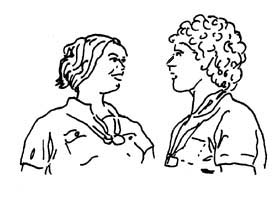CHAPTER ONE
יְחידה אחתIN THIS UNIT YOU WILL:
1. Learn to greet one another and get acquainted in Hebrew using Hebrew names
2. Learn all the letters of the Hebrew alphabet
3. Learn how the dagesh affects pronunciation
4. Recognize how Hebrew is written and read without nikkud
5. Learn classroom phrases and how to respond to simple questions in Hebrew
6. Use the Hebrew alphabet to write the words you and your instructor frequently use
7. Read simple sentences you use
8. Sing two Hebrew songs of hope and brotherhood
9. Use listening-comprehension strategies
10. Pronounce the special sounds of Hebrew
11. Recognize the following grammatical elements in the Hebrew Language:
a
. Prefixes: ו - and; ה the; ב in the, at the, with theb. Gender of nouns
c. Agreement of adjectives with nouns
d. Subject pronouns in the singular
e. זה
and זאת as demonstrative pronouns
![]() Use the Software. Do the
flashcard drills to learn the vocabulary for Chapter One. On the "Main
Menu" screen choose "Flashcard Tools. Then choose #1 in the flashcard
learning modules and do the decks for Chapter One. Advance the level
of difficulty in the flashcard learning modules as you master the
vocabulary.
Use the Software. Do the
flashcard drills to learn the vocabulary for Chapter One. On the "Main
Menu" screen choose "Flashcard Tools. Then choose #1 in the flashcard
learning modules and do the decks for Chapter One. Advance the level
of difficulty in the flashcard learning modules as you master the
vocabulary.
![]() Open the
"Chapter One Exercise Workbook" file from the Chapter One main web page or
the Table of Contents. When open, click on "File" on the top menu bar, and
then on "print" to print the workbook. Use your printed booklet when you see
this icon of a pencil.
Open the
"Chapter One Exercise Workbook" file from the Chapter One main web page or
the Table of Contents. When open, click on "File" on the top menu bar, and
then on "print" to print the workbook. Use your printed booklet when you see
this icon of a pencil.![]()
1
We can begin speaking even before you can read Hebrew.
Let's begin with a two word phrase asking
"who are you? Since you can not yet read the Hebrew letters yet, use the English transcription in red letters. Click on the picture of the earphones to hear the correct pronunciation of the Hebrew.Please note that usually the last syllable of a word is accented. When this is not the case, capital letters are used in the transcription.
100.00 %
Be sure to Read the Hebrew from RIGHT TO LEFT
1. When asking a female Who are you?
say: /mee AT /? מי את?2. When asking a male
Who are you? say: /mee ah-TAH/? מי אתה?who are you? (m)
מי אתה?3. I am Shah-OOL
/ani shah-OOL/ אני שאוּל 4. who are you? (f) /mee AHT/? מי את?5.
I am shoh-SHAH-nah /ani shoh-SHAH-na/ אני שושנה6. Hello, Shah-ool
/shah-lom shah-OOL/ שלום שאול7. Hello, Shoh-sha-nah
/shah-lom shoh-SHAH-nah/ שלום שושנהOf course, when getting acquainted people don't say "who are you". They say "What's your name"
מה שימְךָ \ מה שְמֵךְ /mah-shim-xah (m)?/ mah-shmehx?(f)
Yes, you guessed it!... A person who is eavesdropping on your telephone conversation will always know the gender of the person to whom you are speaking, because the word for "you" is different for male and female!
You (f) - /
aht/ את You (m.) / ah-tah/ - אתהI (m. & f) - /
ah-nee/ אני (the same pronoun for male and female)"hello" or "goodby" - /
sha-LOHM/ שלום
ah-nee stoo-dent
xa-dash
אני
סְטוּדֶנְטית חדשה ah-nee
stoo-den-tiht xa-da-shah 2

The Sounds of Hebrew. Take a Hebrew Name- 1.2
שם, שמותאני _________ . Choosing a Hebrew Name-aniEvery language has a unique style and personality. When we take on a new language we also enter its world of style and flavor, its thought patterns, and idiom. When you speak a different language you may discover that you express yourself with a slightly different personality in the second language... You assume a different persona.
As you begin your journey into Hebrew, we suggest that you choose a Hebrew name as part of your assumption of a "Hebrew alter-ego". Your instructor, and the audio recordings, will model the pronunciation of the names that appear on the following pages and ask you to repeat them. Some of the names will be familiar to you in their English equivalents, since so many of our popular names are derived from biblical sources. Others may appeal to you because of the meaning of the name. (You may like the notion of calling yourself Ora, "light" or Aryeh, "lion".)
T
he list of names contains all of the sounds of Hebrew and all of the letters in the alphabet. But do not expect that you will master them by just reading over the list. Learning to read and write the alphabet is covered in the rest of this chapter.Remember that usually the last syllable of a word is accented. When this is not the case, capital letters are used to show the stressed syllable. (The stress pattern of Hebrew names can vary from formal to informal contexts.)
1.2.1
Now choose the Hebrew name that will be your "persona" in this course. The list of names on the following pages will be helpful, but you need not limit yourself to these suggestions. If you know another name that you prefer, adopt it! Names below that are followed by a * are likely to be accented on the first syllable in informal contexts. Note that in the phonetic transcription used below the letter "x" stands for the sound you make when you pronounce the name Bach.
אני שושנה
/ani shoh-SHAH-na

אני שאוּל
/ani shah-OOL
3
100.00 %
MASCULINE NAMES
FEMININE NAMES
זכר
/za-xar /נקבה
/ ne-keh-vah
הֶעָרָה
Relax, we know!
Yes, you haven't learned the alphabet yet. At this stage in the course you can use the English pronunciation guide. After you know the Hebrew alphabet you can return to read the names in Hebrew.